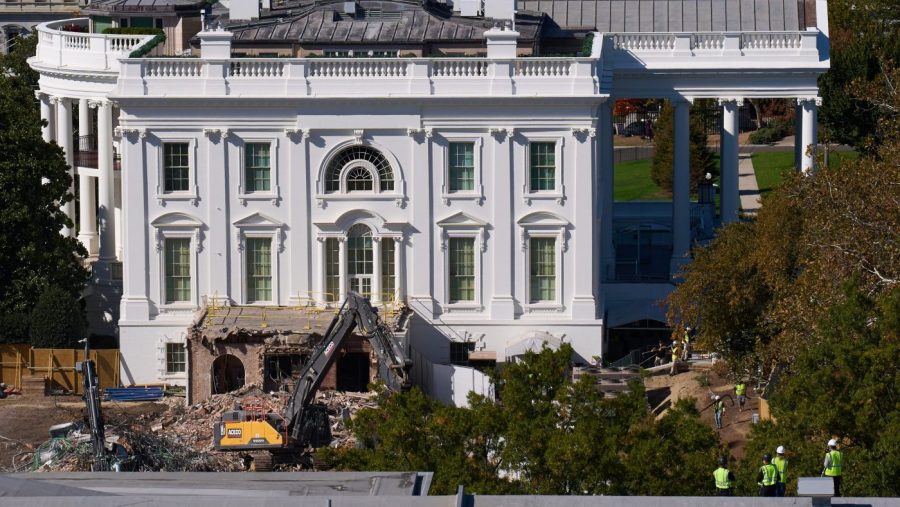Trump’s teardown of White House’s East Wing raises questions of authority

President Trump’s demolition of the White House’s East Wing to make room for a $300 million ballroom has raised questions of who has the authority to allow the work.
Since Monday, demolition crews and an excavator have been spotted tearing down part of the historic building. White House officials have said the 90,000-square-foot privately funded ballroom will be completed before President Trump’s second term ends in 2029.
For any improvements and changes to the executive mansion, the White House must submit construction plans to the National Capital Planning Commission (NCPC), an administration official told The Hill on Thursday.
But while the NCPC has jurisdiction over construction and renovations to the building, it “does not require permits for demolition, only for vertical construction,” the official said.
“Construction plans have not yet been submitted to the NCPC, but they will be at the appropriate time,” according to the official.
Although the commission is closed due to the government shutdown, a letter from the National Trust for Historic Preservation (NTHP) sheds more light on what NCPC’s role is when it comes to making changes to the White House.
The letter, sent Tuesday and written by president and CEO Dr. Carol Quillen to the leadership of NCPC, asked the Trump administration and the National Park Service (NPS) to freeze the demolition.
The White House is a national park and the property, including President’s Park, is owned by the National Park Service, according to its website. Trump met with them, members of the White House staff, the White House Military Office and the Secret Service “to discuss design features and planning” on the ballroom, according to a statement from July.
The Hill reached out to the National Park Service for comment.
Quillen also asked for the administration to “go through the legally required public review processes, including consultation and review by the National Capital Planning Commission and the Commission of Fine Arts, and to invite comment from the public.”
“These processes provide a crucial opportunity for transparency and broad engagement — values that have guided preservation of the White House under every administration going back to the public competition in 1792 that produced the building’s original design,” she wrote.
The Hill reached out to the Commission of Fine Arts for comment. The latter’s website states that it is closed due to the government shutdown.
Former NCPC chairman L. Preston Bryant Jr. told CNN that there is a three-stage process for federal projects that kick off with “collaborative” consultations, followed by conceptional approval, preliminary approval and final approval.
“If there’s to be demolition, that’s part of the project,” said Bryant, who served on the commission from 2009-18, according to LinkedIn. “The demolition element is inherent in the overall project. Demo is not separated from construction. It’s part of it.”
Section 106 of the National Historic Preservation Act requires federal agencies to identify and assess the effects its actions may have on historic buildings.
“Under Section 106, each federal agency must consider public views and concerns about historic preservation issues when making final project decisions,” according to the U.S. General Services Administration’s website.
However, Section 107 exempts the buildings and grounds of White House, the Capitol Building and the Supreme Court from adhering to the previous section.
Last month, Trump’s appointed chair of the commission, Will Scharf, said the ballroom project did not require the panel’s approval for construction to begin, The Associated Press reported.
“I think it’s one of the most exciting construction projects in the modern history of the district, and I think any assertion that this commission should have been consulted earlier than it has been or than it will be is simply false and represents a misunderstanding of this commission’s role in that project,” Scharf said, Politico reported.
According to a White House official, several components of the East Wing were relocated within the complex. The first lady’s office and the social secretary’s office were moved within the White House, while the Military Office, the Graphics and Calligraphy Office, and Visitors Office, along with the Office of Legislative Affairs, were transferred to the Eisenhower Executive Office Building.
The Trump administration has defended the demolition and construction plans for the ballroom, which it called “a bold, necessary addition” to the White House, according to a statement issued Tuesday.
The statement even listed the series of changes, demolitions and additions to the White House since President Theodore Roosevelt’s administration in 1902, when the West Wing was built. It noted an “East Terrace” constructed at that time “eventually became the East Wing.”
“Now, in 2025, President Trump is carrying forward that legacy, breaking ground on a grand ballroom — a transformative addition that will significantly increase the White House’s capacity to host major functions honoring world leaders, foreign nations, and other dignitaries,” the statement read.
But the enthusiasm over the ballroom isn’t widespread among the public. On Wednesday, a YouGov America poll found that 53 percent of Americans somewhat or strongly disapprove of the East Wing’s demolition. Fifty percent disapprove of the plans to build the ballroom.